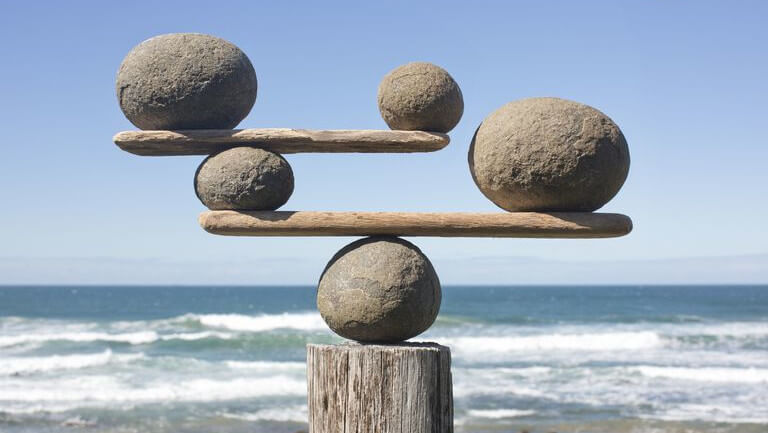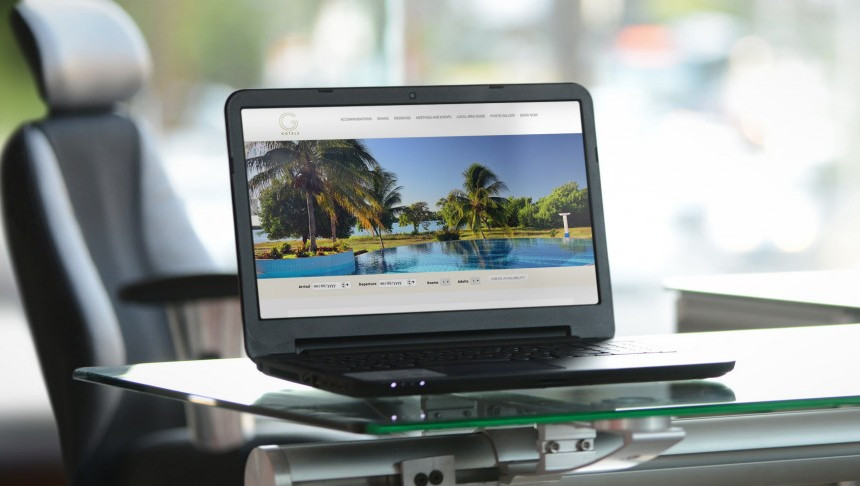One of the biggest issues faced by modern hoteliers is the question of how to increase conversion rates of their hotel websites.
NB: This is an article from The Hotels Network
In your quest to grow direct bookings, rather than investing heavily on website traffic acquisition, it is often more profitable to first focus on better converting your existing traffic. Once potential guests are on your website, it’s important to think about what measures you should take to encourage them to book.
But let’s start with the basics, how to monitor website conversion rates. Your booking conversion rate is the percentage of people who visited your website and ended up booking. It is obtained by dividing the number of direct bookings by the number of unique visitors who visited the website during the same time period, multiplied by 100. Using Google Analytics, you can easily track and analyze all website conversion rates by channel, device, market and much more.
By reducing friction throughout the booking process and providing a personalized website experience, hotel brands can significantly boost their conversion rates. If you are experiencing difficulties in increasing user engagement and subsequent conversions, here are some of the best ways that you can help turn that user into a booker.
Layer
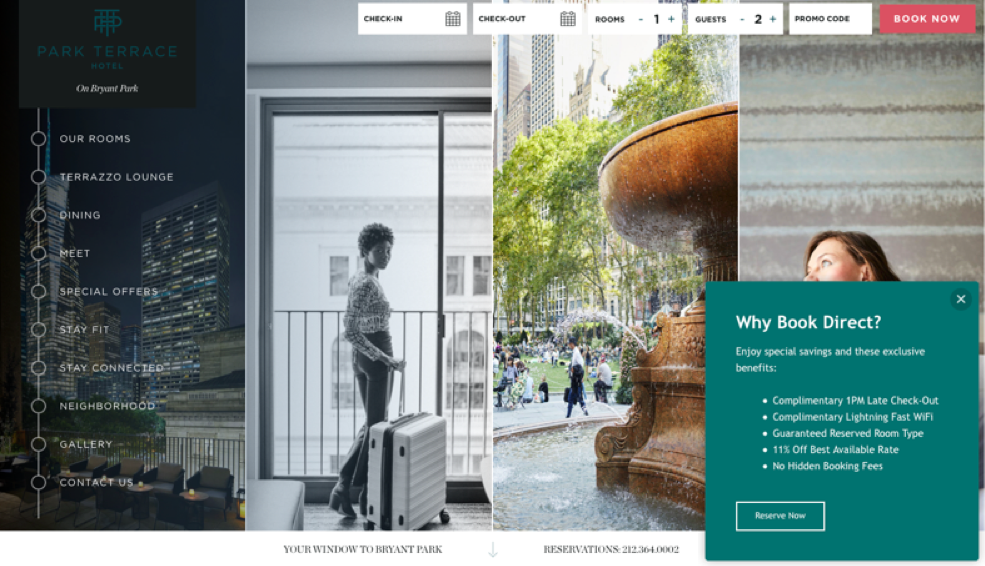
When users enter a website today, they expect to be met with a personalized online experience driven by exciting and engaging content. The first impression that your website gives is highly important as it dictates the user’s future behavior in relation to your site after that point. One possible tool that can be employed on your hotel’s website to make it more attractive and welcoming is a Layer.
A Layer can be used to display a personalized message that appears once a user lands on your website, drawing their attention to what you think is most important. Completely customizable, both the design and extensive targeting options, you can decide exactly what you show to whom, ensuring you display relevant and engaging messages to each and every user.
Fitting perfectly with your brand’s website design, a Layer can be used to highlight your hotel’s unique selling point, your fantastic rating on Tripadvisor or an exclusive deal valid for only certain users. The message you choose to communicate is totally up to you! In the above example, the hotel uses the Layer to stress the advantages of booking direct. To improve its effectiveness, the Layer includes a call to action button to guide the visitor to the rooms & rates page. This will help drive the user further down the booking funnel, maximizing your chances to get more direct bookings.
Tailoring the message using segmentation will also increase the positive impact on conversion. Multiple display rules are possible, from user location or traffic source to booking window or length of stay. You can even build your own custom targeting based on variables in the URL. Displaying a personalized message to the potential guest may just be the tipping point in convincing them to book direct, saving the hotelier from a large commission payment, and in the process, increasing revenue.
Exit Intent
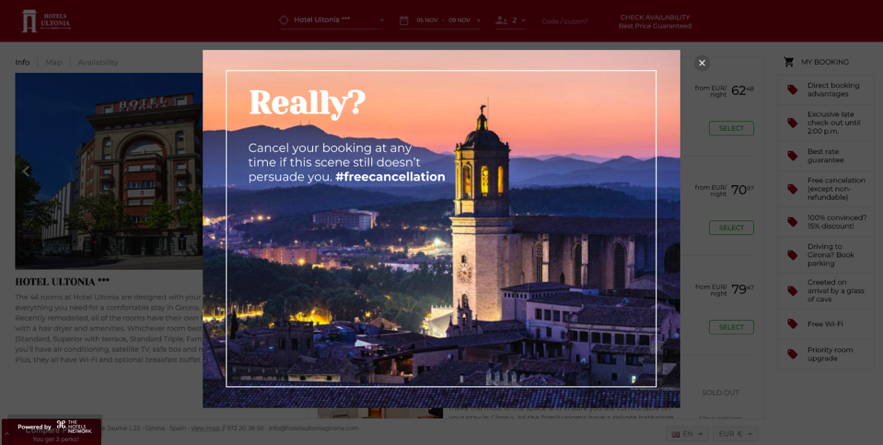
Potential guests can visit a multitude of hotel websites before making their final booking. That is why it is pivotally important to prevent users from leaving your site prematurely. You can do this by showing them personalized messages or special offers designed to draw them back to your site.
Using an Exit Intent is a great way to persuade abandoning visitors to stay on your website. This tool detects when a user is about to leave and automatically displays a message to catch the visitor’s attention. Take advantage of this tool to inform users of any last-minute deals or exclusive perks for booking direct. Maybe offer a 10% discount for those about to leave your Booking Engine? Offer a welcome gift for those exiting from your homepage. Or perhaps you prefer to remind the visitor of what makes your property so distinctive? As before, to improve your conversion rate by ensuring the most relevant message possible, personalize the content of the Exit Intent based on specific targeting options.
In the example above, in additional to trying to seduce the user with a photo of the stunning view, the hotel has taken advantage of this tool to make sure potential guests knows that the hotel offers free cancelation. It’s the perfect way to help reengage someone who was about to leave the website and reassure them that there is no reason not to book today, helping to nudge them towards a booking.
Saved Search
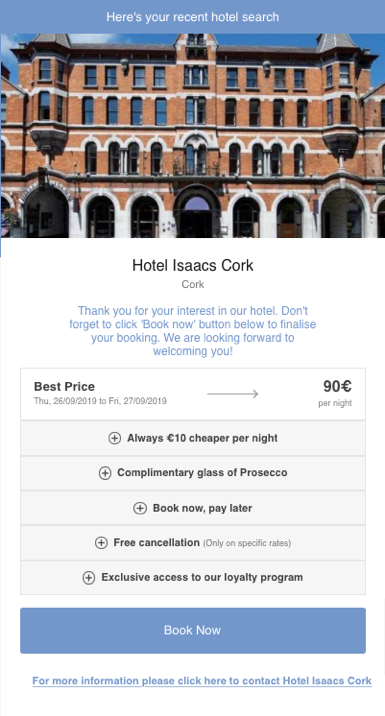
With hotel chains growing so much over the past years, bookers can feel like their voices are not heard, especially if their booking is made through an OTA. One way to show a website user and potential booker that you have taken notice of their curiosity is the Saved Search option.
Saved Search is a technique that helps people who are researching where to stay remember your hotel. Visitors are able to save their searches and receive an automatic email with your best available rate for those dates. When they click on the link in the email, they go straight back to their previous search on your booking engine. This increases hotel conversion rate as it increases the ease with which the potential guest can book whilst showing them that you remember them personally. A sure way to increase hotel direct bookings.
The example above shows an email received by a user who clicked on the “Save Your Search” option within the hotel website. Having previously visited the website and entered in the dates that they wish to occupy, the user can simply click on the link within the email to return directly to the booking page with their previous search content already entered. This maximizes the fluidity and ease of the booking process.
These three tools are only a few of the many ways in which you can personalize the website experience and, as a result, increase conversion rates and direct bookings. If you are able to make your website more engaging, your users will respond more proactively and you’re more likely to get a booking. If you are interested to find out about some other ways to increase your conversion rate or how to boost direct bookings, check out our best practice guides.




